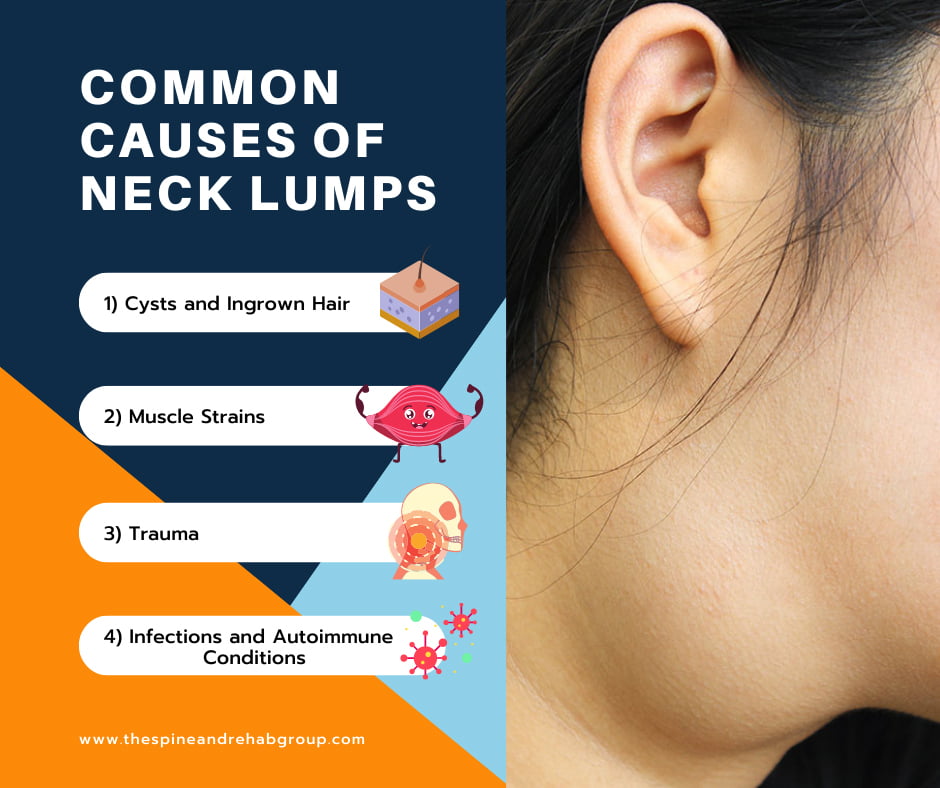 OUR LOCATIONS
Same-day Appointments Book OnlineCall to book 201.523.9590
OUR LOCATIONS
Same-day Appointments Book OnlineCall to book 201.523.9590
 OUR LOCATIONS
Same-day Appointments Book OnlineCall to book 201.523.9590
OUR LOCATIONS
Same-day Appointments Book OnlineCall to book 201.523.9590

Neck lumps or masses are common among American adults. Some people understandably have a paranoid response to feeling a painful lump on the back of the neck. However, these aren’t always a sign of a life-threatening condition. They may be the result of ingrown hairs, benign cysts, or muscle trauma. In some cases, they may also be the result of muscle strains.
So how can you identify the painful lump on the back of your neck? Your doctors will check you for signs of malignancy. If cleared, you’ll undergo further testing to assess if the lump is caused by a skin concern or a muscle injury. There’s also a chance that the lump is a byproduct of a long-term illness.
When you feel a painful neck lump, getting a screening for cancer is often the most common first step. If your doctor concludes that the cause of the lump isn’t malignant, there are still several different conditions that could be causing the pain. It’s important that you work with your doctor in identifying risk factors, such as poor hygiene, recent travels, or previous injuries.
Cysts are common culprits for neck lumps. Small benign cysts are often the result of ingrown hairs trapped underneath the skin. These occur when hair grows downward instead of upward, causing fluid to build up around the follicle. The lump may develop deep within the skin or near the surface. As the lump slowly opens, the yellow or white fluid may come out.
These ingrown hair cysts usually aren’t painful. But when they get infected, they may become tender to the touch. These can usually be treated with home remedies, such as warm compresses. The warmth may help bring the cyst to the surface, making recovery faster. You may also apply tea tree oil to prevent infection.
Pulled muscles may form knots, which can feel like large lumps around the neck. Depending on the severity of the train, the lumps may be pea-sized or grow as large as a tennis ball. These can be felt under the skin and won’t usually appear as a visible lump.
Since the neck muscles are prone to overexertion, it’s important to take breaks from sitting for long hours. It helps to get up and walk for a few minutes to prevent your muscles from tensing up. Muscle knots aren’t a serious medical issue, but they can be painful when not treated.
Lumps caused by strains are felt on the muscle knots rather than the bone or skin. Massaging these can ease the tension. You can also look into neck stretches to correct improper posture. If you’re working from home, you can also invest in an ergonomic setup to prevent hunching over while at work.
Sometimes, people may acquire a sports injury that causes damage to the neck muscles and tissues. Trauma to the neck may force it to forcefully stretch, leading to swelling. Whiplash injuries coming from car accidents and park rides may also lead to painful neck lumps.
Neck pain due to trauma can worsen with movement. Stiffness may prevent you from moving or tilting your neck. If the trauma or injury was severe, other symptoms may accompany the lump—these include dizziness, tinnitus, fatigue, and numbness.
While these are located more along the sides of the neck, swollen lymph nodes may also feel like lumps. These form as a response to an ongoing infection that the body is fighting. Some medications may also trigger this response. Conditions such as lupus, Sjögren’s syndrome, and rheumatoid arthritis also cause swelling in the lymph nodes.
There are cases where the lymph nodes feel painful, although the pain typically subsides once the infection has cleared up. If the pain becomes too persistent, you may also take over-the-counter medications like Tylenol.

To come to a concrete diagnosis regarding the lump, your doctor may order a series of radiologic tests to rule out cancer. You’ll also undergo a series of interviews regarding your medical history. Make sure to be as transparent as possible regarding any past injuries, chronic illnesses, or maintenance medications.
A physical examination is part of most medical check-ups. This allows your doctor to get an initial idea of the possible causes of your condition. Swollen lymph nodes will be felt during a physical exam almost immediately, while ingrown hair cysts will be evaluated based on their appearance and location. Evaluation of possible muscle strains and trauma will be done more slowly to minimize pain and discomfort.
After the physical exam, you’ll be given a copy of the results. If findings show that the problem is benign, you’ll be given advice on how to proceed with treatment. You may be prescribed pain medication or referred to a physical therapist for other options.
A biopsy may be ordered if a swollen lymph node is the cause of the lump. This may be done in the doctor’s office as an outpatient procedure. In smaller lumps, a needle biopsy is enough to get a sample of cells. For larger lumps, you may need to undergo an open biopsy to remove a portion of the lymph node. The samples will be sent to a laboratory for further testing.
3) CT Scan and Other Radiographic Solutions
Depending on the results of your biopsy, your doctor may order a CT scan or other radiographic tests. These include x-rays and magnetic resonance imaging (MRI). You’ll need to prepare for these tests in advance, as they’re typically done in an operating room. These are used to rule out cancers and check for signs of trauma.
In some cases, your doctor may order an endoscopy to check for disease, injury, or trauma along the esophagus. A thin tube with a camera will be used to probe into the area, allowing your doctor to see the upper digestive tract. This procedure may be used to check for tumors.
If you’re looking for an experienced “back pain specialist near me” look no further than The Spine & Rehab Group. Our specialists offer advanced and effective treatment approaches for pain.
If the cause of your neck lumps is benign, your doctor may allow you to pursue non-surgical treatments for pain relief. These should only be done by licensed doctors or therapists, such as the team at The Spine and Rehab Group. Many centers will use a multidisciplinary approach for chronic neck pain.
Physical therapy combines patient education, exercises, and physical manipulation to ensure that the neck properly recovers. It’s most effective for lumps caused by muscle strains and trauma. Doctors will usually recommend physical therapy to help patients regain mobility along the injured area. Patients who experienced trauma after an accident, such as a car collision, may need to see a physical therapist to help them regain neck mobility without pain.
A medical massage can help promote blood flow to the neck muscles. This helps release endorphins to ease the tension felt around the area. Massages are often a component of physical therapy treatment plans, especially in those aiming to increase range of motion in patients.
Acupuncture has its roots in Chinese medicine. It involves the insertion of fine needles to pressure points, each one corresponding with an affected body part. The needles also trigger the release of endorphins to help the body relax and regain its strength.
Trigger point therapy is similar to acupuncture, except fingers are used to relieve the pressure points. Movement is based on a chart showing the trigger points and body parts that correspond with each point. Its goal is to facilitate relaxation along the muscles.
Myofascial release therapy also works by finding pressure points along the body. But unlike acupuncture or trigger point therapy, pressure is applied to a broader area. Your therapist will find areas that feel rigid to the touch, before manipulating them to release the stress and tension.
At The Spine and Rehab Group, we offer different treatments to help you get rid of neck lumps and other painful conditions. We have a team of licensed doctors and therapists to help you achieve long-term pain relief.
If you’re interested in booking an appointment, don’t hesitate to give us a call at 833-847-7463. You may also browse our website for more information.



